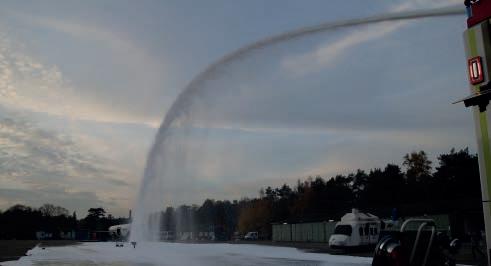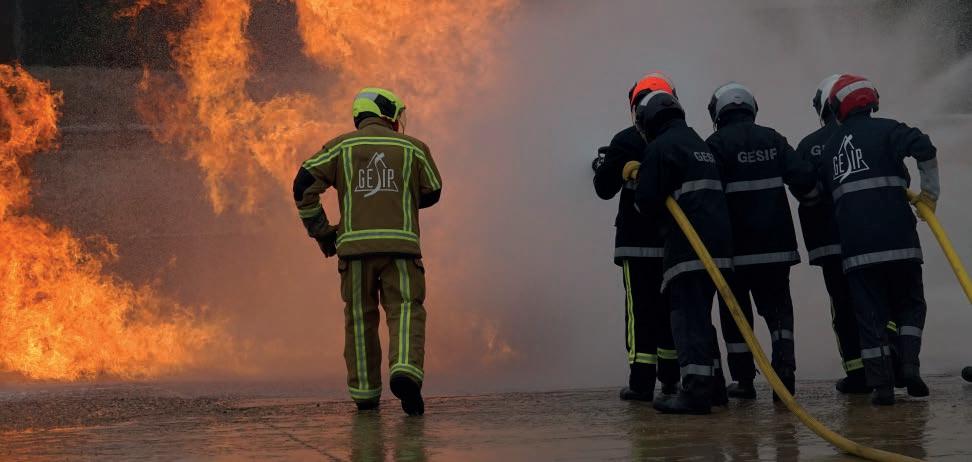JUST TRYING
FOAM FEATURE
HIGH RISK INDUSTRIES IN EUROPE AS WELL FOAM MANUFACTURERS AT THE MOMENT ARE FACING A FAST MOVING DISCUSSION OVER PFAS REGULATION IN FIRE FIGHTING FOAMS. Already regulated substances like PFOS and PFOA are pushing the disussion of foam concepts toward the F3* foams. Overall question is: Can F3 foams substitute the performance of AFFF? What we have already learned from tests in the past is that a one to one replacement of AFFF or AFFF-AR is nearly impossible. Especially concepts which are working with aqueous film formation, like the Footprint™ principle for tank fire fighting (with nearly nonaspirated foam) on non-polar solvents need to be renewed. Using F3 foams for larger class B fuel fires means that foam formation is the key to success. In mobile applications the test of foam expansion ratio is quite easy. Nearly all aspirated foam nozzles and low expansion foam tubes create a good and well performing foam to achive good extinguishing results. [picture bottom right – foam test] But tests on non-aspirated nozzles show that the foam expansion ratio is in relation to the nozzle design, foaming properties of the F3 foam and the pressure at the nozzle. So, a generalisation for the application is not possible and a specific test needs to be carried out. A good foam expansion (ratio) helps the F3 foams to perform as designed. This principle is also confirmed by the EN 1568 part 3 fire test. A foam expansion ratio at the test nozzle near 1:10 is quite
22
good. But how to reduce F3 foams’ fuel pick up? AFFF‘s have a minimal fuel pick up behavior created by the fluorosurfactant. F3 foams do not have any fluorinated raw materials in their composition. Additionally the bubble structure and the application have a huge influence on the fuel pick up capability. Meaning, a more homogenous bubble structure and a less forceful application helps not to load too much fuel into the foam blanket. Of these benefits we have heard for years now from the compressed air foam system (CAFS) manufacturers. Second benefit of CAFS is the extended throwing length of aerated foam. Conventional foam reduces the throwing length up to 30% easily. AFFF foam water solution has nearly the same throwing length as water and was preferred for long distance operations e.g. at loading racks or processing plants. For these reasons it is good to give this technology in combination with F3 foams some more attention. At a client’s site we had the possiblity to attend a training of the plant fire brigade. The test pit has dimensions of 10 m by 20 m (200 sqm) and is filled with approx. 6000 litres of unleaded gasoline. The preburn time was approx. 60 sec. As you see the documentation is not as detailed, because it was more
of a training exercise to collect some experience. The challenge was to extinguish the fire with only one CAFS nozzle at a flow of 400 l/min. foam. Therefore we needed to check the numbers. Regularly we recommend an application rate of 6 - 8 l/min./sqm. For 200 sqm we talk about a realistic application of approx. 1200 l/min. for a safe and fast flame control for in depth fires (more than 25mm fuel depth). The named 400 l/min is compressed air foam, means we are talking about a foam expansion ratio of 1:8. So we are facing a real application of 50 l/min. Compared to EN 1568-3 approval test with an application rate of 2,5 l/min/ sqm we should need an application of 500 l/min [ten times more] foam water solution. Some may ask why so much less application: the explanation is superficial – that was the maximum flow of the CAFS test unit which was available.









